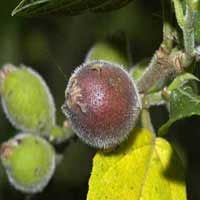 Full List of Fruits
Full List of Fruits  Sandpaper Fig
Sandpaper FigSandpaper Fig Fruit
Scientific name - Ficus coronate
Sandpaper comes under the category of fig trees originating from Australia, the fruit is also known to be the Creek Sandpaper, The tree is generally small in its size with height of 6-12 m which is 20-40 ft with a width of 3-5 m which is 10-15 ft although it is small in size. Their trunk has a bright brown color having leaves which are oval or also elliptical in their shape with the length of 5-12 cm which is 2-6 in and a width of 2-5 cm which is 1-2 in and the texture is very rough in nature similar to that of a sandpaper in its top side, the newly grown one has hairs in it, the fruits are succulent in nature having an oval shape with a width of 1.5 cm known to be 0.6 in and has lots of hairs covered on them. The fruits can be consumed raw and are very tasty and was a source of food for the aborigines earlier.
![]() Nutritional Value of Sandpaper Fig
Nutritional Value of Sandpaper Fig
| Total Fat 0.7g | 1% |
| Saturated Fat -1g | -5% |
| Cholesterol -1mg | -0% |
| Sodium -1mg | -0% |
| Total Carb 30.1g | 10% |
| Dietary Fiber -1g | -4% |
| Sugars -1g | |
| Protein 2.7g | 5% |
| Vitamin A -0% | Vitamin C -2% |
| Calcium -0% | Iron -6% |
The dried part of the leaves which have a rough texture helps in polishing up the wood, metal, ivory based products like kitchen utensils, also in making gourds, sticks, bows, spear shafts, chairs, boards and also bracelets. Also the wood aids in the production of canoes, house posts, furniture, stools, utensils, containers and drums too, they act as fuelwood too and also preparation of charcoal. The immature branches aid in the manufacture of pipe stems.
![]() Health Benefits of Sandpaper Fig
Health Benefits of Sandpaper Fig
The decoction taken from that of the roots aid in solving the complications of urinary tract ailments, gonorrhoea, asthma and also tuberculosis, for treating cough the roots can be chewed, also the root bark helps in combating the eye based problems, the ash obtained from the stem barks can be applied on the wounded areas. Also the barks decoction helps to solve the complications of heart problems, the pre mature leaves are chewed and ate for treating gastric ulcers, the leaf’s juice or also the leafs decoction helps as a enema medicine in solving the problems of stomach ache and also used to counteract on poison. The decoction made from the leafs which are dried helps in curing the diseases of the kidneys and urinary tract, their leaves also aid in healing cough, colds, flu and asthma also a mouthwash prepared with the help of it solves problems of thrush, inflammation of gums, pains in the regions of the mouth and also the throat.
Propagation of sandpaper fig is relatively simple. It can be grown from either seed or cuttings.
Seeds: Sandpaper fig seeds should be collected during the fruiting season, when the fruits are ripe. The seeds can be extracted from the fruits by cutting them open and removing the seed. The seeds should be sown in seed trays filled with a mix of equal parts sand and potting mix. Cover the seed trays with a thin layer of potting mix and keep the soil moist but not wet. The seeds should germinate in two to four weeks. Transplant the seedlings into larger pots when they have reached a height of around 10 cm and keep them moist until they are established.
Cutting: Cuttings can be taken from the tips of young branches. Select a branch that is approximately 10 cm long and make a clean cut just below a node. Remove any leaves from the lower half of the cutting and dip the base in rooting hormone. Place the cutting in a pot filled with a mix of equal parts perlite and sand. Cover the pot with a plastic bag to maintain humidity and keep the cutting in a warm location. After a few weeks, the cutting should have developed roots and can be transplanted into a larger pot.
Care: Sandpaper fig trees are relatively low-maintenance and can be grown in a variety of soil types. They prefer a position in full sun and will require occasional watering during dry spells. Fertilise the trees in spring with a complete fertiliser. Prune the trees in spring to maintain their shape and encourage bushy growth.
Pests and Diseases: Sandpaper figs are relatively resistant to pests and diseases, but may be affected by scale insects, mealybugs, and aphids. The trees can also be affected by root rot, leaf spot, and fungal diseases. Regularly inspect the trees for signs of pests and diseases and treat with an appropriate pesticide, fungicide, or insecticide.
Sandpaper figs are an attractive tree that can be used as a feature tree in the garden. They can be propagated from either seed or cuttings and require only minimal care. With the right care and attention, sandpaper figs will provide shade and fruit for many years to come.


















